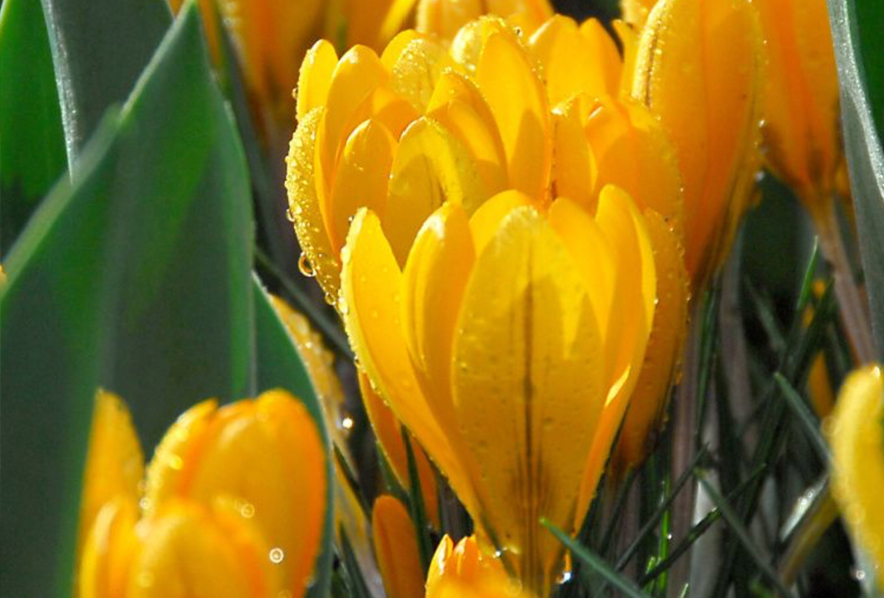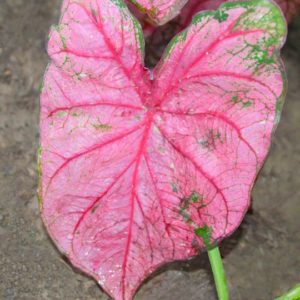Description
 Crocus, flavus
Crocus, flavus
Golden Yellow
Crocus are members of the Iris family and are native to the Mediterranean and parts of Asia. They are among the oldest of the cultivated bulbs. The original crocus was a fall blooming type, Crocus sativus, grown for its saffron in Palestine during King Solomon’s time and used as an important commercial product by various ancient civilizations. Within the first few centuries of the new millennium, the Romans brought crocus to Britain, and by 1330, C.sativus was introduced into Essex via a commercial venture that made yellow dyes.
Crocus is the Chaldean name given to the species by Theophrastus. Theophrastus (370-287 B.C.), a student of Aristotle, was a scholar, botanist, biologist, and physicist. His two major books constitute the first systemization of the botanical world and were major sources for botanical knowledge during antiquity and the Middle Ages. On the strength of these works some call him the “father of botany.” In Greek, the name means saffron. All of the vernus species are deer resistant.
Crocus are found naturally in much of Europe, especially the Mediterranean, in North Africa, and in western Asia as far east as Afghanistan. There are more than 80 species of crocus. They are very early flowering, producing blossoms in the January-March timeframe.
The spring flowering Crocus varieties have never been cultivated for non-gardening purposes, but they have enjoyed enormous popularity as garden flowers. In fact, C. vernus is one of the bulbs credited with starting Holland’s bulb business. Crocus are so much beloved that they were among the first bulbs brought to North America by the earliest settlers. The large flowering crocus also known as “The Wild Crocus of the Alps” were discovered around 1875. All of the crocuses derived from C. flavus were the first yellow crocuses that European gardeners knew for more than 400 years. The plant is native to much of Europe.
Crocus prefer a light, fertile, alkaline soil and good sunlight. Digging them up and dividing them every three years is highly recommended. They are good naturalizers and good for forcing. Deer usually do not like them, but rodents do. Some gardeners have reported that squirrels do not eat or “replant” any of the C. tommasinianus varieties.
The corms should be planted 3-4 inches deep and 2-3 inches apart. Don’t forget to add at least ¼ cup bone meal to the area where the corms are to be planted. They can flourish in full sun to partial shade. Yellow Mammoth is hardy from Hardiness Zone 3-8.
Yellow Mammoth can be ‘forced’ for a mid-winter bloom indoors. This crocus can be ‘forced’ in water and in pots. Getting bulbs to grow and blossom indoors during the winter is known as “Forcing”. “Forcing” means that you trick a bulb into believing that it has awakened from its winter slumber and it is now time for it to produce its spring blooms. Some bulbs can be forced by placing the bulb in water. Many bulbs can be forced by planting them in soil in a pot. With the exception of paperwhites, ALL BULBS MUST BE EXPOSED TO A PERIOD OF COLD FOR AT LEAST 12 WEEKS.
If you are going to force the bulb in soil, then, for best results, place 3-4 bulbs in a 6 inch pot on top of 2 inches of soil, and cover the bulbs with soil leaving only the tips above the surface of the soil. Wrap the pot in a plastic bag and place the pot with the bulbs in the refrigerator for 12 weeks. At the end of the 12 weeks, remove the pot from the refrigerator, water, and place in a cool bright window. Keep the soil moist, but not waterlogged and the pot cool. The bulbs will bloom in about 4 weeks.
If you are going to force the bulb in water, you need to place the bulb in the refrigerator (NOT THE FREEZER) for at least 12 weeks. When you remove the bulb from the refrigerator, place it in a bulb vase or a bowl lined with pebbles. Add water to the base of the bulb and place the vase/bowl in a cool, bright window. The bulb will produce blossoms in about 4 weeks. Only narcissus, hyacinths and crocus may be forced in water.
Planting Bulbs in the Fall for Glorious Spring Color
Bulbs are some of the easiest plants to grow. Fundamentally the process requires four steps.
1. Dig a hole.
2. Dust the hole with bonemeal.
3. Place the bulb in the hole.
4. Fill the hole with soil.
There are, however, some additional refinements which help produce even more lavish results and enhance protection from critters.
First, bulbs can and should be planted deeper than the instructions you receive on the package labels. An easy way to remember how deep to plant the bulb is to think of a quarter. If the bulb you are planting has the same diameter as a quarter or less, plant the bulb 4 inches deep. If the bulb is broader than a quarter, plant it 6-10 inches deep. Large bulbs like some alliums, camassias, standard tulips and fritillaries can easily be planted 10 inches deep. As the soil compacts days, weeks and months after planting, it produces a thinner layer of soil on top of the bulb. Planting bulbs deep helps with critter control. Moles, voles, chipmunks and squirrels are lazy little creatures, and they don’t like doing a lot of digging to reach their food.
Second, bonemeal is a must. It is an excellent source of calcium and phosphorus which help the bulbs to form a strong root system and healthy stems. For large bulbs (those bigger than a quarter), use ¼ cup per bulb. For small bulbs, dust the entire surface or hole where the bulbs will reside.
Third, small bulbs should be planted in clusters of 10 or more – 1 inch apart. Large bulbs, like allium, can stand along, but create a much more pleasing presence in the garden when planted is clusters of 3-5. They should be separated by no more than 4-6 inches.
Fourth, bulbs usually multiply fairly quickly and once crowded will not produce blossoms. Plan to divide your bulbs in mid-summer to fall when the top growth has dried out.
These simple, easy, quick tasks are all that is required to produce a lovely bulb display year after year.
Planting Bulbs in Containers
If you live in Hardiness Zones 5 and higher all you need to do is mix some soil. Check out the soil mix described in detail in our Harvesting History YouTube video. Do not use prepared soil mixes.
The Best Soil Mix for Containers
Always plant bulbs more densely in containers than in the ground. Pots as small as 6-inches in diameter can have a showy presence on a deck, porch or patio. You can use much larger pots and plant several kinds of bulbs.
Fill the pot half full, dust the soil surface with bonemeal, arrange the bulbs on top of the bone meal and fill the pot with the rest of the soil. Dust the surface of the soil with more bonemeal. Water thoroughly, but do not let the pot stand in a saucer of water.
If you live in Hardiness Zones 1-4, you must protect the pots by bringing them into an unheated garage or surrounding them with bales of straw. If you do not do this, the bulbs usually freeze and turn to mush.
Forcing Bulbs
Crocus prefer a light, fertile, alkaline soil and good sunlight. Digging them up and dividing them every three years is highly recommended. They are good naturalizers and good for forcing. Deer usually do not like them, but rodents do. The corms should be planted 4 inches deep and 4 inches apart. Don’t forget to add at least ¼ cup bone meal to the area where the corms are to be planted. They can flourish in full sun to partial shade.
Crocus can be ‘forced’ in water and in pots. Getting bulbs to grow and blossom indoors during the winter is known as “Forcing”. “Forcing” means that you trick a bulb into believing that it has awakened from its winter slumber and it is now time for it to produce its spring blooms. Some bulbs can be forced by placing the bulb in water. Many bulbs can be forced by planting them in soil in a pot. With the exception of paperwhites, ALL BULBS MUST BE EXPOSED TO A PERIOD OF COLD FOR AT LEAST 12 WEEKS.
If you are going to force the bulb in soil, then, for best results, place 3-4 bulbs in a 6 inch pot on top of 2 inches of soil, and cover the bulbs with soil leaving only the tips above the surface of the soil. Wrap the pot in a plastic bag and place the pot with the bulbs in the refrigerator for 12 weeks. At the end of the 12 weeks, remove the pot from the refrigerator, water, and place in a cool bright window. Keep the soil moist, but not waterlogged and the pot cool. The bulbs will bloom in about 4 weeks.
If you are going to force the bulb in water, you need to place the bulb in the refrigerator (NOT THE FREEZER) for at least 12 weeks. When you remove the bulb from the refrigerator, place it in a bulb vase or a bowl lined with pebbles. Add water to the base of the bulb and place the vase/bowl in a cool, bright window. The bulb will produce blossoms in about 4 weeks. Only narcissus, hyacinths and crocus may be forced in water.





